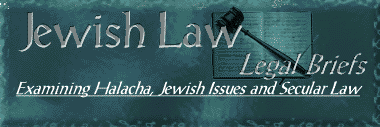

Supreme Court of the United States
INTEREST OF THE AMICUS CURIAE
The AVI CHAI Foundation is a private foundation that was established and endowed in 1984 by Zalman C. Bernstein, of blessed memory. AVI CHAI's mission is to encourage Jews in the United States and Israel to become more deeply involved with Jewish learning, observance and the promotion of mutual understanding and sensitivity among Jews of different religious backgrounds.
In the United States, one of AVI CHAI's primary efforts has been to encourage the growing Jewish day school movement. Over the past 12 months, AVI CHAI has committed almost $28 million for this purpose. There are currently 185,000 American Jewish students enrolled, kindergarten through twelfth grade, in approximately 800 full-time Jewish day schools. These day schools provide comprehensive general-studies education that satisfies the educational requirements of the various States and prepares graduates for college and university. At the same time, these schools offer a range of Jewish studies, as well as a moral education rooted in Jewish values.
AVI CHAI has also invested in research on Jewish education. One study on the finances of Jewish day schools, conducted by Marvin Schick and Jeremy Dauber, showed that Jewish day schools are dramatically under-funded compared to their public school counterparts. On average, Jewish day schools have less funds available per student for religious and general studies combined than public schools do for general studies alone. Supreme Court decisions that have limited government support even for secular materials at parochial schools have had a damaging impact on Jewish day schools.
As an advocate for Jewish day schools, AVI CHAI seeks to expand state aid available for secular materials at parochial schools. Such an expansion can only enhance the quality of secular education at these schools.
THE NATURE OF THE FEDERAL
AND STATE PROGRAMS THAT
ARE AT ISSUE IN THIS CASE
A. Federal Grant Programs.
Chapter 2 of Title I of the Elementary and Secondary Education Act of 1965 ("ESEA") is a federal grant program designed to improve educational opportunities by supporting innovative school programs, promoting promising reform initiatives, providing necessary educational materials, and meeting the needs of at-risk/high cost students. See 20 U.S.C. § 7301(b) (1994). In 1981, Congress consolidated the more than forty categorical programs that now make up Chapter 2 into a single block grant program that provides funds to state and local education agencies ("SEAs" and "LEAs"). See SRI International, How Chapter 2 Operates at the Federal, State, and Local Levels 4 (1994) (hereafter "SRI Report"). The principal effects of the consolidation were to enhance local discretion in how funds were allocated, increase the breadth of distribution of funds to include private school students, and decrease administrative costs. See id.
Chapter 2 requires that LEAs allocate resources equitably between private and public school students. See 20 U.S.C. § 7372(b) (1994). Expenditures for private school students must "be equal (consistent with the number of children to be served) to expenditures for . . . children enrolled in the public schools . . . taking into account the needs of the individual children and other factors which relate to such expenditures . . . ." Id. State and local agencies that receive Chapter 2 funds must also engage in "meaningful consultation" with private school officials within their region to determine what services or benefits the private schools require. 34 C.F.R. § 299.6 (1998). If private school students or educational personnel have different and distinct needs from their public school counterparts, federal guidelines require that public agencies provide services and benefits for those unique needs. See 34 C.F.R. § 299.7 (1998).
Chapter 2 benefits are used by private schools to support a vast array of programs and services. Although only a relatively small percentage of Chapter 2 funds actually go to private schools (three percent of SEA funds and nine percent of LEA funds in 1991-92), the benefits provide an important source of funds and equipment for innovative new educational programs. See SRI Report at 198, 219. Chapter 2 effectively tripled the funds available to private schools as compared to previous programs. See id. at 206. In 1991-92, thirty-nine percent of the nation’s school districts had private schools that were eligible to participate in Chapter 2, and sixty-six percent of those LEAs actually supported private schools. See id. at 211. During the same period, thirty-four percent of private schools participated in Chapter 2 programs. See id. at 200.
Although virtually every aspect of elementary and secondary education is supported by Chapter 2 benefits, many private schools use the funds to acquire educational materials and computer equipment. See id. at 211. The most common use of Chapter 2 benefits – used in eighty-six percent of schools – is to purchase instructional and educational materials for libraries and media centers. See id. at 210. Additionally, more than forty percent of private schools use Chapter 2 funds to purchase computer hardware and software. See id. Chapter 2 benefits are also commonly used for staff development, programs for at-risk students, innovative programs, and general school-wide improvement. See id.
B. Federal Safeguards Against Use for Religious Indoctrination.
Chapter 2 and the Department of Education’s associated implementing regulations contain substantive and procedural provisions designed to prevent the use of secular materials for religious indoctrination. Chapter 2 places two principal substantive restrictions on funds allocated to private schools. First, the expenditures must support "secular, neutral, and nonideological services, materials, and equipment." See 20 U.S.C. § 7372(a)(1) (1994). Second, the expenditures must supplement, rather than supplant, funding from non-federal sources. See 20 U.S.C. § 7371(b) (1994).
Chapter 2 also contains procedural requirements designed to prevent public funds from being employed by private schools for religious indoctrination. Title to all materials and equipment purchased for private schools using Chapter 2 funds must remain with the public agency, which is also charged with maintaining administrative control over the materials. See 20 U.S.C. § 7372(c)(1) (1994). Department of Education regulations further dictate how materials purchased with Chapter 2 funds must be used, requiring that the supplies be used only for "proper purposes," that the materials can be easily removed, and that the materials are removed when they are no longer needed for the specific program for which they were purchased. See 34 C.F.R. § 299.9 (1998). Chapter 2 also requires that if a public agency contracts with an outside entity to provide services to private schools, the contracted entity must be wholly independent of any religious organization. See 20 U.S.C. § 7372(c)(2) (1994).
Further safeguards, although not dictated by federal statutes or regulations, are also commonly instituted by SEAs and LEAs. See SRI Report at 147-48. In order to receive Chapter 2 benefits that go to private schools, LEAs must submit applications to their respective SEAs. These applications include "statements of assurance (e.g., community consultation), planned activities, program participant counts, a budget, and other attachments that the state may require." Id. at 125. State agencies review these applications, along with other LEA evaluations, as well as conducting periodic site visits to ensure compliance with federal and state regulations. See id. at 148-50. Finally, many SEAs and LEAs also require that materials purchased with Chapter 2 funds be conspicuously marked as such. See id. at 212. Although, for reasons stated at pp. 20-23, infra, we do not believe that these measures are constitutionally necessary, they reduce the possibility that secular materials provided by government will be used for religious indoctrination.
C. State Programs.
Nearly half of the States provide financial, material, or service benefits to non-public schools within their jurisdictions. See Education Commission of the States: Clearinghouse Notes, 1993-94 State Aid to Non-Public Schools 1 (September 1997) (hereafter "ECS State Aid"). There is significant variety in state programs, ranging from transportation services to grants for specific education programs. See id. at 6. Additionally, every State’s constitution or legislative code has provisions that serve to guard against violations of the Establishment and Free Exercise Clauses of the United States Constitution. See Education Commission of the States: Clearinghouse Notes, State Constitutions and Public Education Governance 1-2 (June 1999).
Eighteen States have programs by which private school students are provided with textbooks. See Appendix I, pp. 1a-8a, infra. These programs vary significantly, but they generally provide either free or subsidized textbooks to approved private schools for non-religious courses of instruction. See, e.g., Miss. Code Ann. § 37-43-1 (1972) (providing free state-owned textbooks to approved non-public schools); Ind. Code § 20-8.1-9-9.5 (1990) (reimbursing parents of non-public school children for textbooks when children are eligible for federal free lunch programs).
The next most common use of targeted public benefits for private schools is the provision of free transportation for students traveling to and from school. See ECS State Aid at 6. Fourteen States either provide free transportation or reimburse parents of children who attend private school for their transportation costs. See id. at 1-5. Common restrictions placed on the transportation benefits often include that the private school be state-approved (see, e.g., Iowa Code § 285.1 (1997)) or that private school students not displace public school students on the buses (see, e.g., N.D. Cent. Code § 15-34.2-16 (1999)).
Several States provide funding or services for specific educational programs. Most commonly, States provide benefits for students who require special education when they are unable to attend public schools. See, e.g., Miss. Code Ann. § 37-23-69 (1972) (providing a graduated reimbursement rate for special education services); Wis. Stat. § 115.791 (1999) (providing procedures for full reimbursement of costs for non-public special education programs); N.C. Gen. Stat. § 115C-115 (1998) (providing public payment of tuition for private school special education programs when public facilities and personnel are unavailable). Additionally, States also offer special instruction to non-public school students who would, if in public schools, be eligible for "compensatory" programs to improve math or language skills. See, e.g., N.J. Stat. Ann. § 18A:46A-1, 4 (West 1999). Other specialized benefits include driver education (see Del. Code Ann. tit. 14, § 127 (1998)), violence prevention (see Minn. Stat. § 120B.22 (1998)), and drug, alcohol, and tobacco education (see N.J. Stat. Ann. 18A:40A-5 (West 1999)).
Some States also provide teaching materials other than textbooks to non-public schools. See, e.g., Ohio Rev. Code Ann. § 3317.06 (Anderson 1999) (providing secular, neutral, and nonideological software and video materials, and limited computer hardware to non-public schools). In some cases, States specifically distinguish between more traditional and non-technologically advanced instructional materials that can be provided, and computer software and hardware that cannot be given to non-public schools. See 22 Pa. Cons. Stat. § 115.1 (1999) (providing numerous materials including compasses and protractors but not computer materials).
Several States provide for private schools to be reimbursed for costs imposed by state-mandated administrative and testing programs. See, e.g., Ohio Rev. Code Ann. § 3317.063 (Anderson 1999) (reimbursing private schools for clerical and administrative costs incurred due to state and local regulations). Similarly, some States reimburse private schools for costs associated with state free-meal programs for students, even when the programs are not required. See, e.g., 105 Ill. Comp. Stat. 125/2 (West 1998) (allowing reimbursement for non-profit private and parochial schools that participate in state free-breakfast and lunch programs).
Finally, a number of States provide funds for in-school medical care to non-public schools. See, e.g., N.J. Stat. Ann. § 18A:40-25 (West 1999) (providing nursing care); Conn. Gen. Stat. § 10-217a (1998) (mandating public provision of equivalent medical services for public and private school students). These statutes typically apply to both sectarian and non-sectarian institutions. See id. See Appendix II, p. 9a, infra, for a listing of the different categories of state assistance and an enumeration of the States that provide programs in each category.
1 | 2 | 3 | 4 | 5 | 6
Page 2 of 6 |
